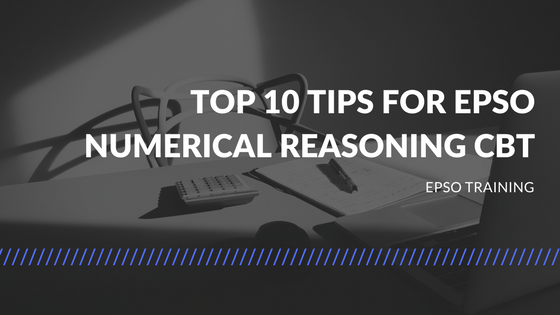
Top 10 Tips for Epso Numerical Reasoning CBT
Since you are here, then you are most probably invited to take EPSO’s MCQ (Multiple Choice Question) tests! One important part of it that you must ace is the Numerical Reasoning. If you are feeling a little insecure about how you will do in this particular test, don’t be. Because here at EPSO Training, we aim to guide you in your journey towards your dream EPSO career.
In this article, we have you covered with all the important things you need to know about Numerical Reasoning CBT (Computer-based Test). What is more, right at the end, we offer you ten crucial tips that will help you pass the test in flying colors!
What Is EPSO Numerical Reasoning Test
First on the agenda, what is EPSO’s Numerical Reasoning Test? According to EPSO’s website, it is a test that assesses your ability to think logically and understand numerical information. To put it simply, like all the other reasoning skills tests under the MCQ, the numerical reasoning test uses data that, instead of letters or words, is expressed with the use of digits, ratios, percentages, tables, and the likes.
This test is used in the assessment of candidates who are applying to all EPSO positions. There are usually ten numerical reasoning questions for which they have to answer in 20 minutes. The focus is on candidates ability to find the specific information asked from the numerical data provided. They must draw conclusions and calculate changes within the data sets. Usually, these tables center on different European economic subjects.
To pass the Numerical Reasoning test, the candidate must get 50%. However, with the number of competitions, candidates must strive to get a higher score of around 80% to ensure that they will get an invitation to the next phases of the EPSO competitions.
Why Does EPSO Use the Numerical Reasoning Test
In essence, the use of numerical reasoning tests and other psychometric tests helps employers assess whether a candidate is fit for the job. These tests are great at predicting future job performance, identifying in a quick, accurate, fair, and low-cost manner.
What is more, most workplace roles involve dealing with numerical data. Those with higher levels of numerical reasoning ability are more likely to quickly grasp numerical concepts, effectively solve problems, and make logical decisions, most especially involving numbers.
How to Prepare for the Numerical Reasoning Test
Now to the juicy part. How can you best prepare for the numerical reasoning test? To best illustrate, let us look at some sample questions.
- What was the number of live births in total in the three most populous EU capitals in 2017?
Option A: 35.08
Option B: 14,729
Option C: 151,764
Option D: 231,973
Option E: None of the above
Solution:
The three most populous EU capitals in 2017 were London, Paris, and Berlin.
# of live birth in London = 8,790 * 8.6 = 75,594
# of live birth in Berlin = 3,711 * 11.58 = 42,973
# of live birth in Paris = 2,228 * 14.9 = 33,197
Total number of live birth = 75,594 + 42,973 + 33,197 = 151,764
- What was the ratio between the number of deaths in Brussels in 2017 to that in Amsterdam?
Option A: 6:5
Option B: 8:9
Option C: 11:13
Option D: 137:100
Option E: None of the above
Solution:
Number of deaths in Brussels in 2017 = 1,175 * 11.1 = 13,043
Number of deaths in Amsterdam in 2017 = 856 * 12.5 = 10,700
The ratio is [Number of deaths in Brussels] : [Number of deaths in Amsterdam] = 13,043 : 10,700 = 6 : 5
- It is estimated that the population under 15 in Berlin will decrease by 1.4% in 2018, comparing to 2017, and remain the same in London. What would be the difference between the population under 15 in London and Berlin in 2018?
Option A: 2.7
Option B: 988,200
Option C: 996,516
Option D: 1,040,394
Option E: None of the above
Solution:
the population under 15 in Berlin in 2017 = 3,711,000 * 0.16 = 594,000
the population under 15 in Berlin in 2018 = 594,000 * (1 – 0.014) = 585,684
the population under 15 in London in 2018 = 8,790,000 * 0.18 = 1,582,200
Difference the population under 15 in London – the population under 15 in Berlin = 1,582,200 – 585,684 = 996,516
As you can see from above, each question refers to the statistical table before it which covers a particular subject. In this case, the table centers on the City Population Composition in the year 2017.
Now let us look at question number one as an example, which asks “What was the number of live births in total in the three most populous EU capitals in 2017?” The answer is Option C. Looking at it, the question asks you to add the number of live births in the three most populous EU capitals. These are: London, Berlin, and Paris.
As such, the rests of the questions asks you to deal with the numerical data on the table and conduct the appropriate calculations in order to solve it. That is why it is very important that you must get yourself familiar with mathematical equations together with how you translate the data well according to what is asked of it. It is also very handy to use a calculator in some hard cases, which tend to require more than one calculation.
Ten Tips to Ace Your Numerical Reasoning Test
Finally, we are down to the namesake of this article. Before diving deep into taking the test, it is very crucial that you equip yourself with some tips and tricks that can help separate yourself form the competition. Thorough familiarization with formulas paired with some strategies is undeniably the perfect combination to not only pass but ace this test. Below are the ten tips you need to keep in mind:
1. Know the test format – The first thing you need to search for is how the Epso Numerical Reasoning exam is structured. You can go on and search this on Epso’s website and through official journals of the competition or you can read on. Regardless of the EU competition – be it Administrator or Assistant, the numerical reasoning exam is made of 10 questions for which you will have 20 minutes to solve. The questions will present a table or a chart with a brief explanation of the context, a question on the table/chart and then 5 possible answers from which only one is right. This CBT (computer based testing) epso numerical reasoning test follows right after the epso verbal reasoning exam and is followed by the abstract reasoning one.
2. Budget your time – Two minutes / question some would say that it’s more than enough, others that it’s clearly not sufficient. It all depends on your previous numerical skills and exercise. Someone with technical background might find the Epso Numerical Reasoning exercises a piece of cake while people with other skills might find the questions a bit tricky. In both cases, you should always keep an eye on the clock and try to fit in the two minutes time frame for each question. In exam conditions, it’s easy to get stuck with a particular question and waste more time on it. The best option would be just to mark the question and if time allows it come back to it in the end. If there’s no time, don’t leave the question unanswered and make an educated or a lucky guess.
3. Read the statements carefully – It is essential for the epso numerical reasoning test to make sure you have clearly understood what is wanted from the statement. Double check the tables with the data from which you deduct the answer.
4. Make use of given items – In the CBT exam room you will receive rough paper, marker and a calculator. Mark down complex calculations on the rough paper so that when you would need to go back to that value it stays written. Also, if you would want to revise a particular question, you would have the data already calculated on the rough paper. During the exam, some people prefer the real-life calculator, others the virtual calculator available in the test engine. It’s a personal choice, but in both cases you should make sure that you are typing the correct data into it.
5. Prepare well – Depending on the level of the competition, the difficulty of the questions is different. For an Administrator exam, the epso numerical reasoning questions could be more difficult and with more calculations than for an Assistant exam. Prepare to meet the same type of exercises – addition, subtraction, multiplication, division, decimal numbers, fractions, percentage – but a different difficulty scale depending on the published EPSO competition. You should be prepared for this situation and practice well in advance for epso tests.
6. Avoid stupid mistakes –Make sure to avoid stupid mistakes that could cost you precious points. One could look at another column in the table, mistype values on the calculator or even check a wrong answer after calculating the correct answer. Try as much as possible to stay focused and do not let these type of mistakes affect your score.
7. Ease your job – Depending on the type of exercise you could round up or down the values given for easier calculations. You will find the answer only by approximation but it will clearly increase your speed of solving the exercise.
8. Check unit measurement – Always look at the unit measurement that data is presented and how the answers are shown. It could be that a value is in thousands while the answer is in millions. In this case, the wrong answer would always be there to trick you so make sure you look for these details and express the answer in the right unit of measurement.
9. Revise if time allows it – If you have enough time, it would be a good idea to go again though the epso numerical reasoning questions, especially through the “marked for review” ones. Just go and validate the logic, re-read the question and see if you took the right data from the tables.
10. Practice makes perfect – I’ve saved the best advice for the end. You should practice as much as possible before the CBT exam date. This way you’ll be able to assess your performance, identify your weakest points and track your progress. Remember that it’s not about passing the EPSO Numerical Reasoning exam but having one of the best scores to allow you to advance to the Assessment Centre that’s why focus and speed have a large impact on the score.
Go ahead and check out our FREE EPSO Tests or start an intense preparation for EPSO Numerical Reasoning Tests
Search Now
Recent Posts
-
On-Going Now: The Competition for EPSO’s Administrators in the Field of Audit Has Begun!
https://epsotraining.eu/wordpress/blog/2018/05/09/epso-administrators-audit-2018/ On-Going Now: The Competition for EPSO’s
No comments -
EPSO’s Graduate Administrators (AD5) Opens this March 2018
https://epsotraining.eu/wordpress/blog/2018/03/05/epsos-graduate-administrators-ad5-opens-this-march-2018/ EPSO’s Graduate
No comments -
Upcoming EPSO Competitions 2016
https://epsotraining.eu/wordpress/blog/2016/05/25/epso_competitions_2016/ Upcoming EPSO Competitions 2016 2016-05-25 18:45:46
No comments -
Administrators competition 2016 in the field of audit launched
https://epsotraining.eu/wordpress/blog/2016/05/16/notice-open-competition-administrators-field-audit/ Administrators competit
No comments




